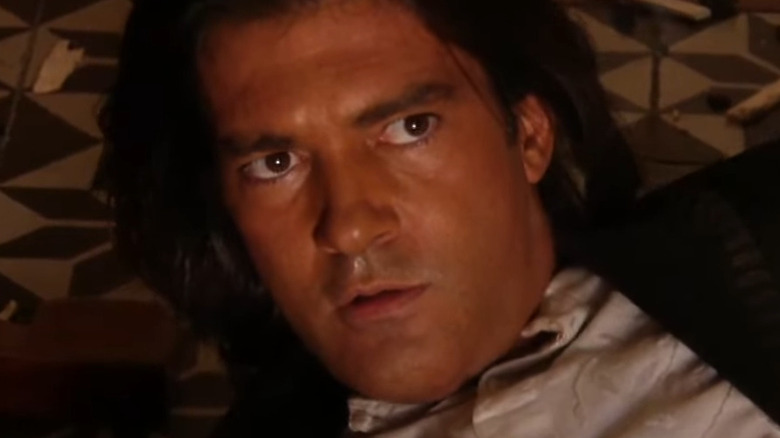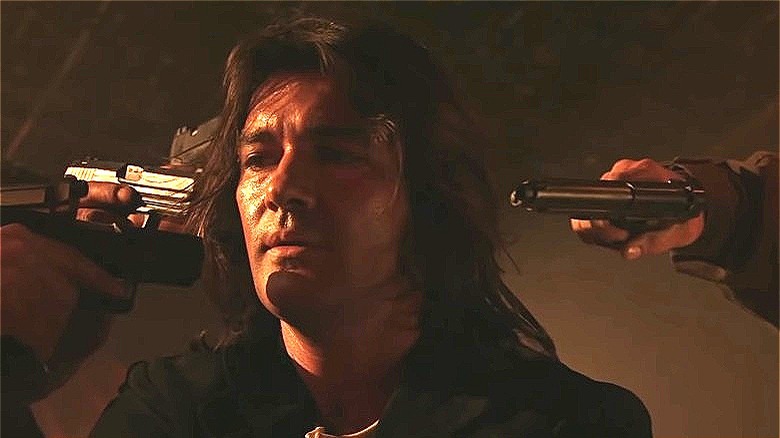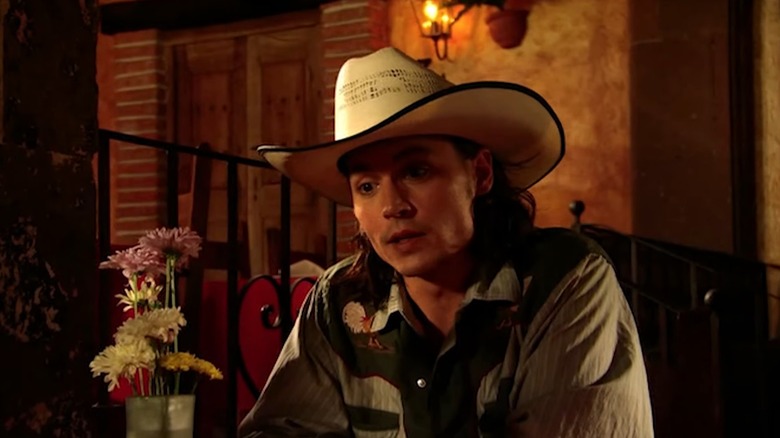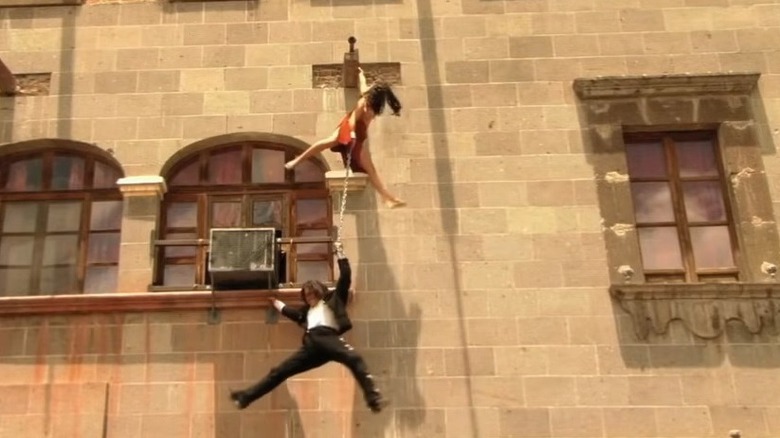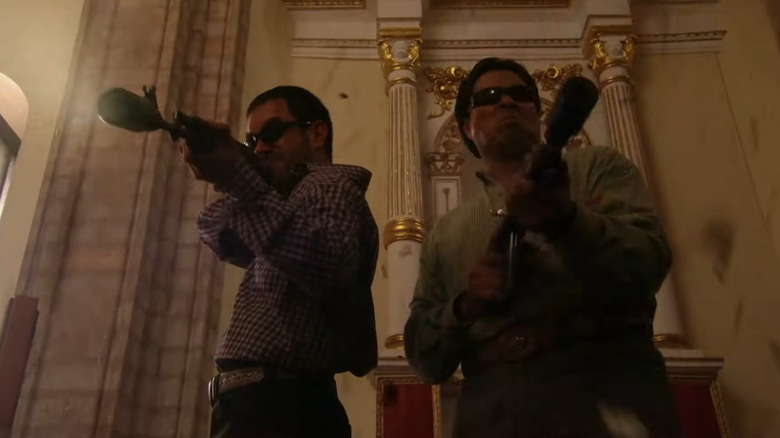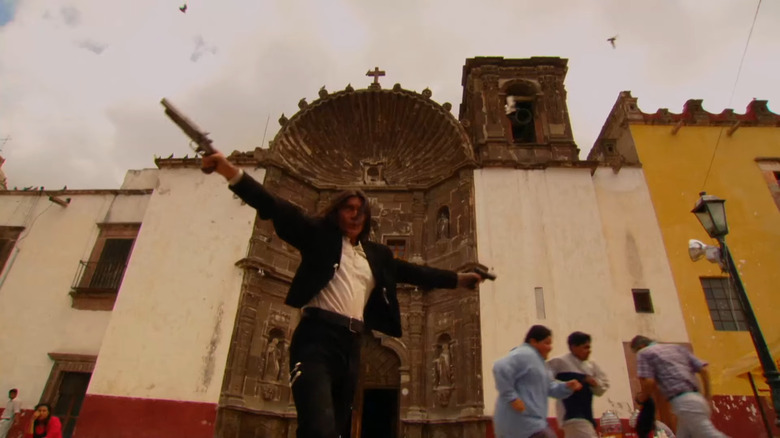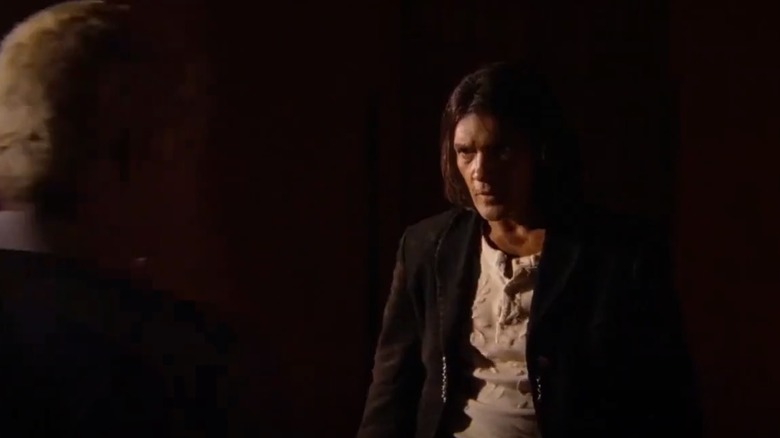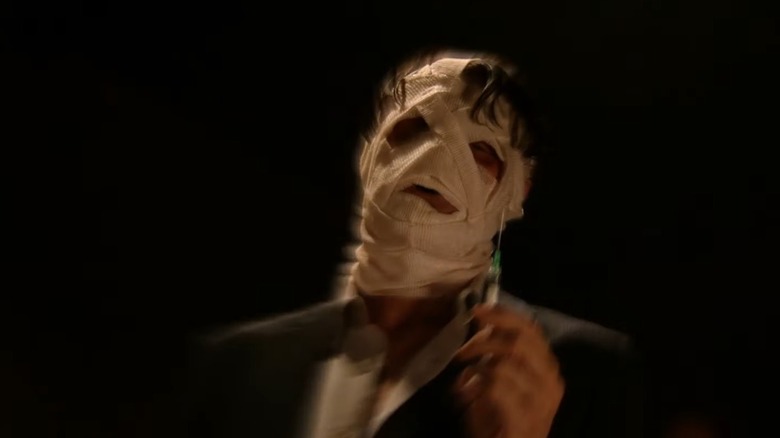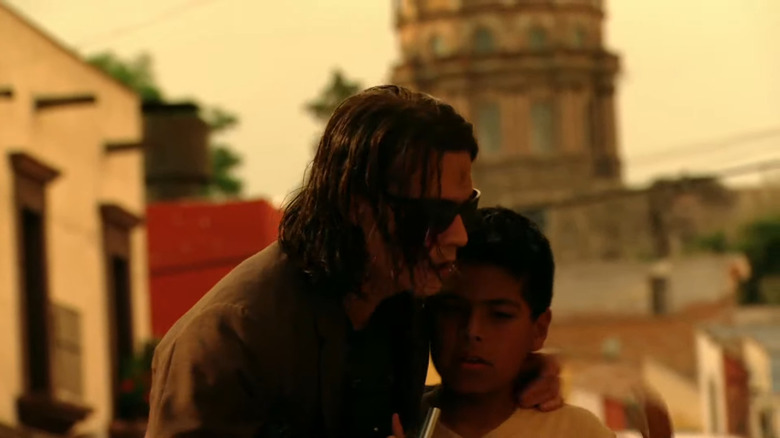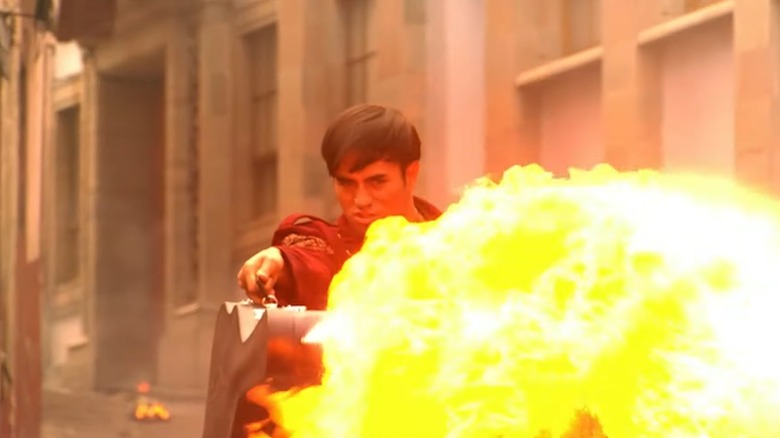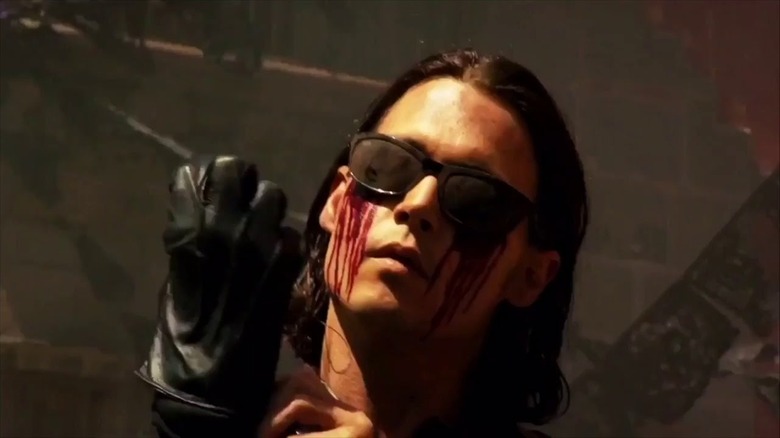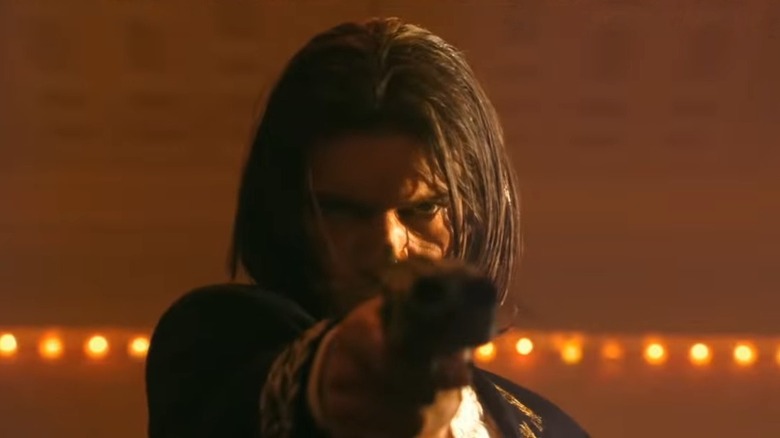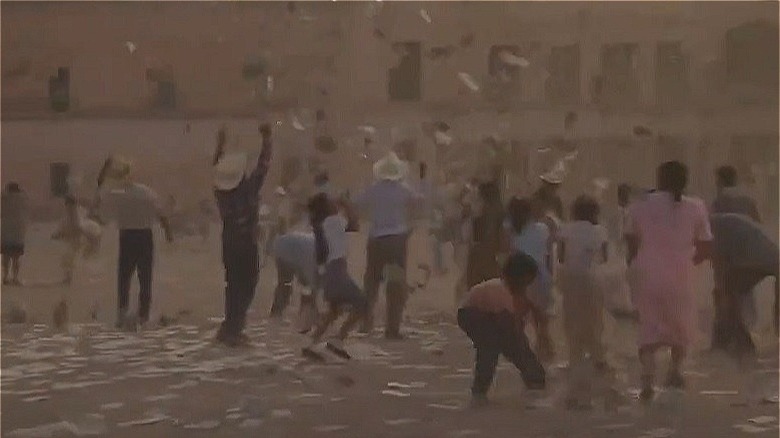Every Iconic Moment From Once Upon A Time In Mexico
This content was paid for by Sony and created by Looper.
There's no doubt that filmmaker Robert Rodriguez is a fan of Sergio Leone, since his films practically drip as tributes to the Italian master of the spaghetti Western. Rodriguez even admitted to BBC that the third gun-slinging film in his "Mexico Trilogy," "Once Upon a Time in Mexico," was created in the same vein and spirit as 1966's "The Good, the Bad and the Ugly" by employing multiple protagonists throughout the story. Star power is a quality that Rodriguez's neo-Western doesn't lack, as it features Antonio Banderas and Salma Hayek reprising their roles from "Desperado" as the mysterious El Mariachi and Carolina respectively, while Johnny Depp's Agent Sands, Willem Dafoe's Armando Barillo, and crooner Enrique Iglesias' Lorenzo join the mayhem as new additions as well.
Since Rodriguez took on the writing, directing, scoring, editing, and cinematography duties, it's safe to say that "Once Upon a Time in Mexico" is his definitive vision — and no one needs to start a petition to see his director's cut because this is it. Delicately balanced between violence and unabashed old-school cinematic fun, the film provides many fan-favorite moments that deserve to be revisited and discussed in detail. So let's whip out the guitar, strum a poignant tune, and take a look at every iconic moment from "Once Upon a Time in Mexico."
The legend of El Mariachi
Who is El Mariachi — is he a man or myth? That's the question the informant known as Belini (Cheech Marin) tries to answer for all of us. Agent Sands meets up with Belini at the beginning of the film and the conversation steers to El Mariachi's legend and notoriety in Mexico. Belini recounts a tale of El Mariachi facing off against General Marquez and his men in a cantina. Marquez stands up, one hand tensing over his weapon, as El Mariachi does the same. It's a typical showdown at high noon — but in a drinking hole — as everyone waits for either man to make their move. The guitar man does so first; however, it's his six-string that he reaches for and gently makes it weep. The onlookers laugh at him, until the guitar starts unloading a round of bullets on them. The ensuing gunfight is over the top and explosive, as El Mariachi leaps through the air in slow-mo and blasts his opponents into smithereens. Carolina makes an appearance, too, as she shoots General Marquez, though he survives.
Belini openly admits that stories about El Mariachi may have grown extra tails and become embellished over time. However, this scene serves as a good introduction for anyone who might not have been familiar with the previous entries in the "Mexico Trilogy." It also helps to establish the credible threat of General Marquez and why he and El Mariachi are on a collision course.
Shoot the cook
Agent Sands provides most of the quirky comic relief in "Once Upon a Time in Mexico." While he isn't the kind of individual anyone would want to get too close to — mostly because he can't be trusted and has homicidal tendencies — he certainly knows how to captivate an audience with engaging conversation. Sands meets El Mariachi at a restaurant for the first time. It's here, in this intimate setting, that the CIA agent reveals Armando Barillo bought General Marquez to assassinate the president and overthrow the government. Sands explains how he wants the musical action man to go after the dastardly general.
Sands likes to speak in riddles and metaphors, explaining why his puerco pibil dish is the best he's ever had and almost too good. For this very reason, he needs to shoot the cook to restore balance — much like how it needs to happen in Mexico. El Mariachi disagrees with him about the quality of the dish, but that doesn't stop Sands from paying his check and putting a bullet in the cook before he leaves the restaurant. One wonders what he would have done had the puerco pibil been terrible or had a fly in it. Despite the gruesome outcome and the poor cook's fate, it's still a humorous scene that shows Sands' strange nature and warped view of the world.
Unchained melody
A pivotal underlying theme of "Once Upon a Time in Mexico" is about El Mariachi coming to terms with the loss of his love and mother of his child, Carolina. Throughout the film, he drifts away into dreams of their time together — both the good and bad. In one scene, he is taken back to waking up next to her in a hotel room. It's a sweet, tender moment between the two — until he notices something: They're both chained to each other (and not by choice). A hailstorm of gunfire rains through the open window, as the two dodge what appears to be an inevitable death.
They try to leave the hotel, but the gunmen have them surrounded. With no other option, they leap out of the open window of the fifth floor and hang on the side of the building, utilizing the chains to swing each other from ledge to ledge and eventual safety. It's a nervy and imaginative sequence of events, showcasing how the trust between El Mariachi and Carolina is essential to their survival against all odds. Even when they're surrounded, with seemingly nowhere left to go, they make it out alive due to the power of love.
Pray for their sins
For all intents and purposes, a church should be a safe haven. It's a place for prayer and reflection, which all people should respect as a sanctuary. In "Once Upon a Time in Mexico," the church acts as a meeting point for El Mariachi and Sands, who is disguised as a priest. They convene in the confessional booth and exchange a quick conversation before El Mariachi asks when does his mission begin. Sands departs immediately, as the Barillo cartel enters the place of worship and opens fire on the confessional booth. Ducking and diving his assailants, El Mariachi escapes to the upper level of the church where a game of cat and mouse claws at our last nerve, with the guitar man drumming his fingers on his guitar's body for added tension.
The scene culminates with a fiery shootout within the church's hallowed walls. At the same time, it's hilarious to see how the cartel tries to let an elderly lady continue with her prayers and doesn't stop her when she eventually decides to leave the church. It's a brief second that shows the bad guys might love their anarchy and violence, but they're still good Catholic boys at heart who try to respect their elders and their prayer time.
The chase scene
In a film all about double crosses and treachery, one should have put good money on Sands' right-hand man, Cucuy (Danny Trejo), turning on his boss. Cucuy's heel turn occurs in the biggest action scene of "Once Upon a Time in Mexico." Set slap bang in center of the town, El Mariachi becomes surrounded from every angle. Expectedly, he doesn't go down without a fight, as he spins around and tags all comers with poise and grace.
As he becomes outnumbered and motorcyclists roar into the picture, El Mariachi grabs a nearby bike and hightails it too. A thrilling and high-speed chase ensues, and the hero trades in his bike for a pink convertible near the finish line of this heart-stopping scene. Unfortunately, he's met by a tranquilizer from Cucuy, which neutralizes him upon impact. The different phases of this action scene make for riveting viewing, as it takes the audience from zero to a hundred in a matter of minutes. Rather than make it all about blood and guts, Robert Rodriguez shows off his creativity and eye for a layered sequence that tells us more El Mariachi's Swiss Army knife approach to action than we might not have known beforehand.
Torturing the torturers
Think of some of the most iconic movie torture scenes of all time. They usually involve someone tied to a chair and having their fingernails plucked out, or having metal rods stabbed into their legs for the high-voltage electric charge to flow through them. In "Once Upon a Time in Mexico," the victim turns the tables on the torturers.
With a groggy El Mariachi seated on a chair and experiencing flashbacks of the death of Carolina and his daughter, the torture crew would be smart to leave him alone and not poke the wounded bear. Instead, they peacock around and try to look menacing in an attempt to intimidate him. Bad move. One of them gets his crotch kicked all the way up to his tonsils, while the other two get their family jewels squeezed and twisted until they can hit the high notes of every Mariah Carey ballad. It's a particularly painful scene to watch, but it's also a wonderful subversion of the age-old interrogation trope, introducing a fresh and "twisted" angle — even if it's a painful one for the torturers.
Ajedrez betrays Sands and takes his eyes
Agent Sands plays a dangerous game in "Once Upon a Time in Mexico." No one can accuse him of lacking smarts, though, as he orchestrates a plan in the middle of all the confusion, so that he can grab the cash and ride off into the sunset with Ajedrez. It's so devious and brilliant that it can't fail, right? Well, it does, mostly because he didn't do his due diligence on Ajedrez's background. She betrays him, revealing she's actually Armando Barillo's daughter.
Her betrayal isn't simply an ah-ha moment where she exposes her true identity in a villainous monologue and leaves him hanging in the lurch. Nope, she and her father drug Sands, and do something far worse to him. They take out his eyes because he's seen too much. It's a metaphorical moment in the film since Sands has watched on for so long, accumulating knowledge and setting up all the players so he can win in the end. Now that he can't do this any longer, his approach will need to change. It also proves to be a crucial turning point for this morally ambiguous character.
Sands finds a new pair of eyes
When Agent Sands steps outside after his encounter with Ajedrez and her father, he is blind. That doesn't mean his other senses have abandoned him, though, as his intuition tells him he is being followed by someone who isn't about to help him cross the road or offer to get him to a doctor. Fortuitously, Sands bumps into the little boy who sold him bubblegum earlier in the film and pays him to be his "eyes." Realizing his stalking isn't about to go away, Sands tries to convince the boy to shoot the man following them, but the child is justifiably hesitant. Eventually, Sands decides he'll do it himself but misses several shots and finds himself totally exposed. However, before the gunman can pull the trigger, the boy kicks the gun over to his new pal, who doesn't miss the target this time around.
There's a sweet innocence to this scene at the start, as the boy shows he's more than willing to help Sands but he doesn't want to become a murderer in the process. When all is said and done, he doesn't pull the trigger, but he stays loyal to Sands by passing the figurative and literal loaded gun to him. Does this signify the loss of innocence for the child now? Perhaps.
The guitars explode with the sound of music
"Once Upon a Time" introduces us to two new mariachis: Lorenzo and Fideo. Not much is revealed about these two enigmatic figures, except that Lorenzo is a talented singer and Fideo loves to drink until he can't stand no more. However, El Mariachi sees something in them, and this is the team he personally chooses to take on General Marquez and his army. The fact that he chose only two other people to take on a military operation should have said it all, really.
For the better part of the film, we don't see Lorenzo and Fideo get involved in the action...until the final act. With the streets of Culiacán littered with Marquez's men, the Day of the Dead celebrations turned to ash, and El Mariachi inside the presidential palace, the other mariachis show their mettle. Lorenzo points his guitar at the soldiers, lighting them up with a wave of fire that could have come straight out of a Rammstein live show, while Fideo utilizes a remote-controlled guitar case to deliver a special present to the army: a bomb. They take the action further by turning their attention to the presidential palace and joining their compadre to form a three-man wrecking crew that makes superhero groups look like chumps in comparison. Mariachis assemble!
Sands proves his skills
Despite everything that happened to him, Agent Sands still has hopes of grabbing all the cash. Unfortunately, he and the boy aren't able to get into the city center before the coup d'état, so he needs to step out into the warzone. Standing in front of the presidential palace, Sands tells the boy to hit the road as two armed men walk out the door. This looks like it'll be his last stand, as he refuses to back down or give up on his plan.
Sands fires off his gun but misses. The men laugh, not realizing this was all a part of the agent's plan. Thanks to their giggles, he is able to identify where they are and shoot again. He hits one of the men, while he's shot by the other. Again, he uses his sense of hearing to locate the remaining gunman and tags him. The scene is important for two reasons: One, it establishes Sand as an intelligent and real threat who deserves to be taken seriously. And two, just because Sands' ability to see is taken away from him, it doesn't mean there's anything wrong with his other senses.
The final showdown between El Mariachi and General Marquez
Belini's story comes full circle as El Mariachi and General Marquez meet once again. This time, though, the stakes are far more personal. This isn't only about the safety of Mexico and its government, but it's also about vengeance and retribution for Carolina and her daughter. The two stare down each other, exchanging civil trash talk, which is a welcome change. However, El Mariachi wastes no time, refusing to turn this into a drawn-out affair and blowing off the general's kneecaps with his first move. He stands over the wounded Marquez and pulls the trigger one last time, sending his nemesis straight to Hell without the need to ask for directions.
El Mariachi finally gets his revenge for what General Marquez did to his family. As he holds the pendant that Marquez took from Carolina in his hands once more, it's evident that a weight has been lifted from his shoulders and he finds closure. He'll never get his family back, and that will still eat at him for the rest of his life, but at least he tasted the sweet, satisfying taste of revenge by finishing off the man who committed the heinous crime.
The sharing of the wealth
When Culiacán is attacked by General Marquez's army, the citizens fight back. They might not have access to the same artillery or training as the soldiers, but they refuse to take it lying down, standing up for their city and president by using Molotov cocktails and anything else they can find. It's something that might not have been expected by the bad guys; however, it proves to be an inspiring scene as it turns the citizens into something more than merely passengers of their own story.
Elsewhere, Lorenzo and Fideo help the president to escape from the palace and also discover all the cash that Barillo had organized to pay Marquez. The two mariachis take some dough for their troubles, while the rest of the money rains down on the city. The people show their delight as they shower in the downpour of riches and reach for the bills: a fitting reward for their efforts. More importantly, it's a feel-good ending for "Once Upon a Time in Mexico" as the wealth is distributed among everyone here.
